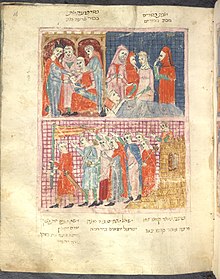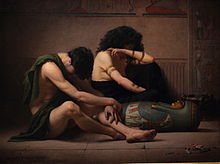Plagues of Egypt
[4][5]: 81 [6]: 6–7 Some scholars have suggested that the story of the Plagues of Egypt might have been inspired by natural phenomena like epidemics, although these theories are considered uncertain.If you refuse to let them go and continue to hold them back, the hand of the LORD will bring a terrible plague on your livestock in the field—on your horses and donkeys and camels and on your cattle and sheep and goats.Then the LORD said to Moses and Aaron, "Take handfuls of soot from a furnace and have Moses toss it into the air in the presence of Pharaoh.They will fill your houses and those of all your officials and all the Egyptians—something neither your fathers nor your forefathers have ever seen from the day they settled in this land till now.Then the LORD said to Moses, "Stretch out your hand toward the sky so that darkness will spread over Egypt—darkness that can be felt."[25] Graham Davies, however, questions Van Seters' interpretation and argues that several verses in the book (e.g. Deuteronomy 6:22; 11:2–3) seem to clearly allude to a plague tradition.[27]: 83–84 In this final version, the first nine plagues form three triads, each of which God introduces by informing Moses of the main lesson it will teach.[2]: 117 Secular scholars broadly agree that the Exodus is not a historical account and that, while a small group of proto-Israelites may have originated from Egypt, it did not happen in the massive way the Bible describes.[29] The Ipuwer Papyrus, written no earlier than the late Twelfth Dynasty of Egypt (c. 1991–1803 BCE),[30] has been put forward in popular literature as confirmation of the biblical account, most notably because of its statement that "the river is blood" and its frequent references to servants running away; however, these arguments ignore the many points on which Ipuwer contradicts Exodus, such as Asiatics arriving in Egypt rather than leaving and the fact that the "river is blood" phrase probably refers to the red sediment colouring the Nile during disastrous floods, or is simply a poetic image of turmoil.Still, relatively few depictions in art emerged compared to other religious themes until the 19th century, when the plagues became more common subjects, with John Martin and Joseph Turner producing notable canvases.Given the importance of noble patronage throughout Western art history, the plagues may have found consistent disfavor because the stories emphasize the limits of a monarch's power, and images of lice, locusts, darkness, and boils were ill-suited for decoration in palaces and churches.[citation needed] Perhaps the most successful artistic representation of the plagues is Handel's oratorio Israel in Egypt, which, like his perennial favorite, "Messiah", takes a libretto entirely from scripture.





Book of ExodusPharaohBritish LibraryHebrewYahwehEgyptiansthe PharaohIsraelitesEgyptian godsPassover SederTanakhepidemicsJames TissotHebrew BibleVa'eiraToggenburg BiblepassoverNational Library of IsraelBook of DeuteronomyPsalms 78Sources and parallels of the ExodusSecularthe ExodusCanaanCanaanitesIpuwer PapyrusTwelfth Dynasty of EgyptsupernaturalCharles Sprague PearceJohn MartinJoseph TurnerOrientalismHandel'sIsrael in EgyptMessiahMetallicaThe Exodus DecodedThe Ten CommandmentsThe Moon of IsraelThe Abominable Dr. PhibesThe Seventh SignThe Prince of EgyptMagnoliaThe MummyThe ReapingSeder-MasochismJames Jacques Joseph TissotJewish Museum, New YorkGustave DoréThe Seventh Plague of EgyptHolman BibleAaron's rodJochebedMiriamInternational Critical CommentaryBloomsbury PublishingAfikomanHa Lachma AnyaMa Nishtana"Outstretched Arm"White House Passover SederHaggadahAdir HuChad GadyaDayenuEchad Mi YodeaL'Shana Haba'ahVehi SheamdaAmsterdam HaggadahBirds' Head HaggadahMaxwell House HaggadahSarajevo HaggadahSzyk HaggadahWashington HaggadahMatzahChremslachMatzah ballMatzah breiMatzo lasagnaMatzah mealMatzah pizzaMatzoquilesStreit'sManischewitzRené NeymannYehuda MatzosRakusen'sBrisketPotato kugelEgg kichelFlourless chocolate cakeHadji badaMacaroonMarunchinosMeringueBedikat ChametzFast of the FirstbornEve of Passover on ShabbatPassover sacrificeChol HaMoedMimounaIsru ChagPesach SheniChametzKitniyotGebrochtsSong of SongsPrayer for dew